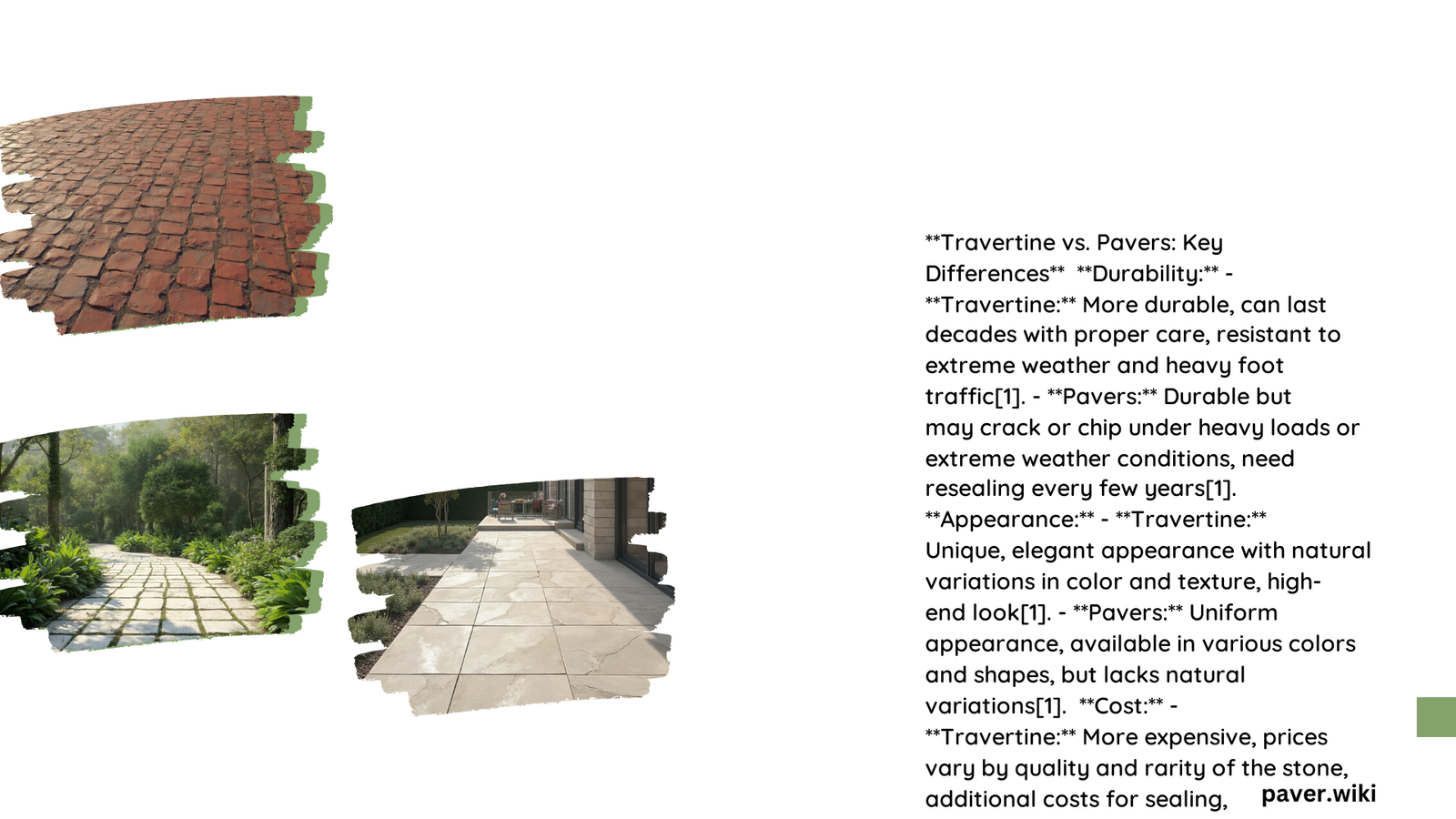When it comes to outdoor flooring options, the choice between pavers and travertine is a common dilemma for homeowners. Both materials offer unique benefits and drawbacks. Pavers are versatile and come in various styles, while travertine provides a luxurious, natural stone appearance. The decision often depends on factors such as durability, cost, maintenance, and aesthetic preferences. This comprehensive comparison will help you determine which option is better suited for your specific needs and circumstances.
What Are the Key Differences Between Pavers and Travertine?
Pavers and travertine are two distinct materials used for outdoor flooring:
- Pavers:
- Man-made concrete blocks
- Available in various shapes, sizes, and colors
- Typically less expensive than travertine
-
Easier to install and replace individual pieces
-
Travertine:
- Natural stone formed from limestone deposits
- Unique patterns and textures
- Higher initial cost but potentially longer-lasting
- Adds a luxurious, timeless appeal to outdoor spaces
How Do Pavers and Travertine Compare in Terms of Durability?

Lifespan
- Pavers: 20-30 years with proper maintenance
- Travertine: 50-100 years or more when properly cared for
Weather Resistance
| Material | Freeze-Thaw Resistance | UV Resistance |
|---|---|---|
| Pavers | Good | Good |
| Travertine | Moderate (needs proper sealing) | Excellent |
Load-Bearing Capacity
Travertine has a higher compressive strength (around 8000 PSI) compared to most concrete pavers, making it suitable for high-traffic areas and heavy loads.
What Are the Cost Implications of Choosing Pavers vs. Travertine?
Initial Installation Costs
- Pavers: $5-$15 per square foot
- Travertine: $15-$30 per square foot
Long-Term Maintenance Expenses
While travertine has a higher upfront cost, it may lead to long-term savings due to its durability and lower maintenance requirements. Pavers might need more frequent repairs and replacements over time.
How Do Maintenance Requirements Differ Between Pavers and Travertine?
Pavers Maintenance
- Regular sweeping and cleaning
- Periodic resealing (every 3-5 years)
- Potential weed growth between joints
- May require sand refilling in joints
Travertine Maintenance
- Monthly sweeping to remove debris
- Annual washing with mild detergents
- Sealing every 1-2 years ($0.50-$2 per square foot)
- Avoid acidic or abrasive cleaners
Which Option Offers Better Aesthetic Appeal and Design Versatility?
Pavers
- Wide range of colors, shapes, and patterns
- Can mimic natural stone or create unique designs
- Suitable for various architectural styles
Travertine
- Natural, elegant appearance
- Limited color palette (ivory, walnut, gold, occasional reds and blues)
- Unique textures and finishes (tumbled, honed)
- Adds a luxurious touch to landscapes
How Do Pavers and Travertine Impact Property Value?
Both materials can enhance property value, but travertine is often considered a premium option:
- Pavers: Can increase property value by 5-10%
- Travertine: May boost property value by 10-15% due to its luxury appeal
What Are the Environmental Considerations for Pavers vs. Travertine?
Pavers
- Made from manufactured materials
- Some eco-friendly options available (permeable pavers)
- Can be recycled at the end of their lifecycle
Travertine
- Natural stone, quarried from the earth
- Non-renewable resource
- Longer lifespan reduces need for replacement
Which Option Is Better for Specific Outdoor Applications?
| Application | Better Option | Reason |
|---|---|---|
| Driveways | Pavers | More resistant to oil stains and vehicle weight |
| Pool Decks | Travertine | Naturally cool surface, slip-resistant when textured |
| Patios | Either | Depends on aesthetic preference and budget |
| Walkways | Either | Both offer good durability and design options |
What Are the Installation Challenges for Pavers and Travertine?
Pavers Installation
- Relatively straightforward
- Can be a DIY project for skilled homeowners
- Requires proper base preparation and edging
Travertine Installation
- More complex, often requires professional installation
- Needs careful handling to prevent chipping or breaking
- Proper sealing is crucial for longevity
In conclusion, the choice between pavers and travertine depends on your specific needs, budget, and aesthetic preferences. Pavers offer versatility and lower initial costs, while travertine provides a luxurious appearance and potentially longer lifespan. Consider factors such as climate, intended use, and maintenance capabilities when making your decision.
References:
1. DPG Pavers – Why Travertine Pavers Are The Perfect Choice For Any Climate
2. Cobblestone Driveway – Durability and Longevity of Travertine Cobblestone Pavers
3. NT Pavers – Travertine Tile Lifespan & Durability: A Complete Guide
